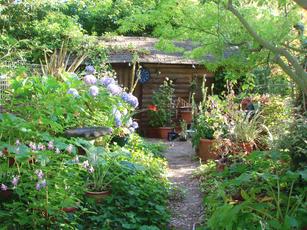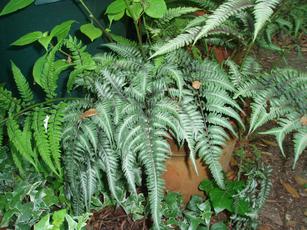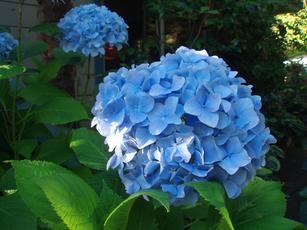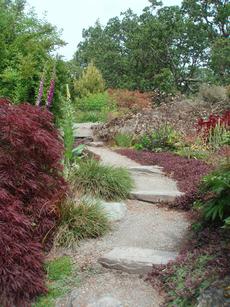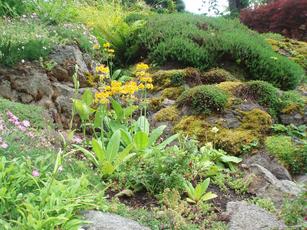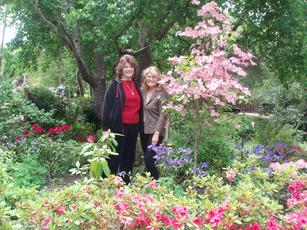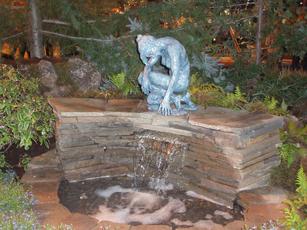To quote Luther Burbank, "Flowers always make people better, happier and more helpful; they are sunshine, food and medicine for the soul". After visiting the garden of Bev Kaplan in Boulder Creek I couldn't agree more.
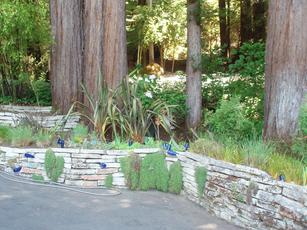 I never tire of being invited to spend time with a fellow gardening enthusiast. Everyone creates a unique garden which reflects their individuality and personality. To share a garden is a personal experience. To tell the story of each part and how it came to life is a special honor bestowed on those we care about. Here is the story of Bev's garden.
I never tire of being invited to spend time with a fellow gardening enthusiast. Everyone creates a unique garden which reflects their individuality and personality. To share a garden is a personal experience. To tell the story of each part and how it came to life is a special honor bestowed on those we care about. Here is the story of Bev's garden.
Bev and her husband, Jeff, bought the property in 1992. Then it was covered with poison oak and Scotch broom but they saw potential and got started on the dramatic transformation. A huge culvert that runs under the driveway used to be lined with old Texaco 50 gallon drums. Now redone with stone, it blooms with agapanthus that were being given away by a friend. Groundcovers blanket the slopes now but in the winter the culvert carries a lot of water.
Bordering the driveway are planters built with concrete from the old pool. Her "designer" bearded iris have finished blooming but Bev bragged about the huge 6" flowers that they bear each spring. Deer can reach this part of the property so iris and grasses survive well here.
A steep slope along another side of the driveway is home to her resident deer. She pointed to the wisteria vines growing over the trees. When in bloom they cover the slope with purple blooms and a wonderful fragrance. She started the wisteria 14 years ago from one seed collected from the hamburger joint at the southern edge of Boulder Creek. It took 7 years for it to bloom but now when the seed pods burst they hit the kitchen window a hundred feet away.
Strolling under the Southern magnolia tree with those huge, white flowers that smell like oranges, we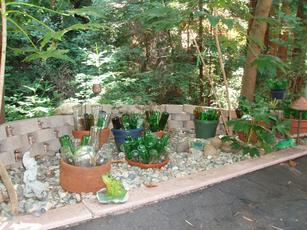 passed the "Bottle Garden". Bev explained she just gave up trying to grow anything in this shady area so made bouquets of colored bottles placed upside down in pots. It's charming, whimsical and the ultimate in recycling.
passed the "Bottle Garden". Bev explained she just gave up trying to grow anything in this shady area so made bouquets of colored bottles placed upside down in pots. It's charming, whimsical and the ultimate in recycling.
"Maple Lane" was our next destination. Her large Japanese maple collection grows happily alongside abutilon, which are also called Flowering maples. Hummingbirds enjoy all of the flowers equally be they colored red, orange or yellow. Sweet violets and astilbe find homes here, too.
A welcoming flagstone patio under the shade of massive redwoods held a large firepit and lots of chairs. Calling her home, "Bev's Bread and Breakfast", she explained that many relatives come from out of town to stay and the warmth of the fire ring is welcomed by those who are used to warmer nights. Camellias and rhododendrons enclose this beautiful patio with a view of the San Lorenzo Valley.
Everywhere I looked in this garden, glass beads were sprinkled between stepping stones. Like jewels, I was told these "Pixie Fairy Gems" keep the weeds down and invite the fairies – clear ones brightened up the shade, blue ones nestled between the brick-red stepping stones in the hospital area.
Opposite the hospital area, which didn't house any current patients I noticed, a several bowling balls sat atop a patch of Mexican pebbles. These belonged to her husband's late parents and she wanted to remember them by creating this unusual garden.
 Finally arriving at the pool garden I was speechless. This labor of love is a riot of color attracting dragonflies, hummingbirds and songbirds and butterflies by the score. I asked how she takes care of all of it. Bev smiled and pulled out a large serving spoon and a pair of kitchen shears. "With these", she said.
Finally arriving at the pool garden I was speechless. This labor of love is a riot of color attracting dragonflies, hummingbirds and songbirds and butterflies by the score. I asked how she takes care of all of it. Bev smiled and pulled out a large serving spoon and a pair of kitchen shears. "With these", she said.
During a delicious lunch of spinach souffle and fresh lemonade with mint, I was surrounded by the fragrance of honeysuckle, star jasmine, scented geraniums, buddleja, nemesia, purple petunia and dianthus. Many varieties of salvia, calibrachoa, scaevola, dahlia and gladiola filled the many pots and hanging baskets around the pool.
Bev takes care of the entire garden with just a little help. She doesn't spray with anything, even organics, preferring to keep bugs at bay by washing the deck with simple green, hand picking and spritzing with the hose.
It was a day I'll always remember. This garden is a personal labor of love and I hope to be invited back to see the hawk babies when they fledge.

